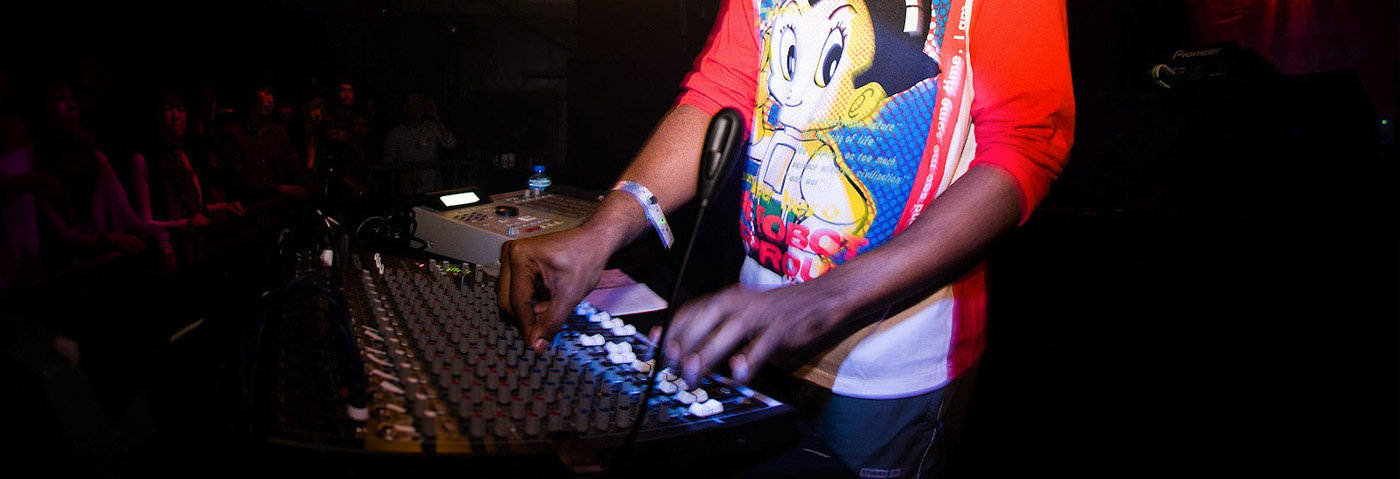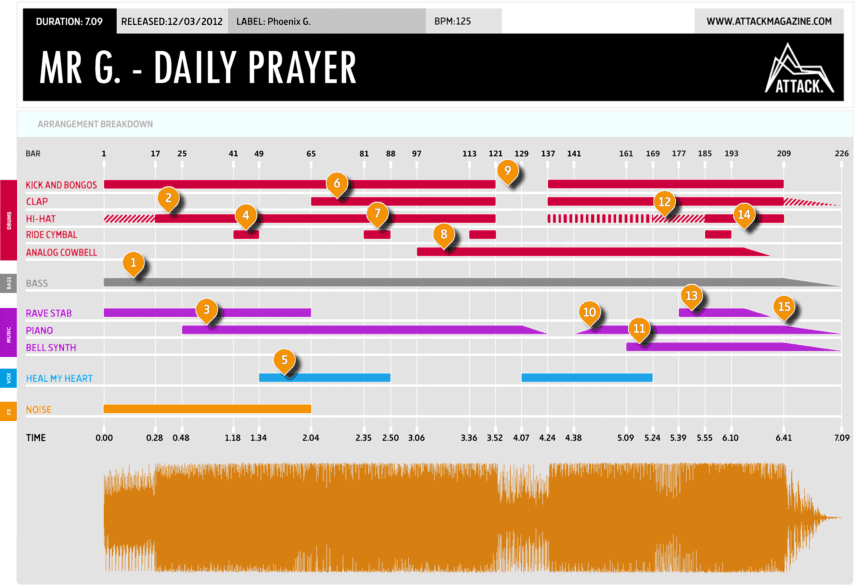Unique arrangements often come from unusual approaches. Mr G’s MPC-driven mixes teach us a lot about raw, hands-on music making.
In the Deconstructed series, we analyse the arrangements of tracks to see what we can learn from their structure. Tech-house legend Colin McBean’s approach to arranging his tracks is decidedly old-school, mixing them down in real time with his trusty Akai MPC 2000XL playing loops and samples. Tracks are muted and levels adjusted on the fly, effects are added and EQs are tweaked. The whole process is recorded live and repeated until he hits a performance he’s happy with.
Below, we break down the structure of the deep and soulful ‘Daily Prayer’ from his Up Hill Battle EP.
You can read more about Mr G’s production process in our interview about the making of his A Night On The Town? album.
THE TRACK
THE ARRANGEMENT
(Click to enlarge.)
WHAT’S HAPPENING?
- Upon starting the track, the groove and emotion are immediately assigned by Mr G’s choice of sounds. We’re hearing a strong rhythmic section of drums including bongos, hats and a low cut kick. The bassline is also very prominent and works in tandem with the subtle bongos, which help generate low-frequency movement.
- After 16 bars of intro, the energy is lifted with a combination of off-beat cymbals and hats. The addition of high frequencies adds more movement and much needed variation to this section. The lead rave stab continues to resonate ominously over the top of the beat.
- A sequence of jazzy piano chords comes in a a low volume, allowing the melody to build tension over the following six bars. The chords are very much a reflection of Mr G himself and the ability to combine a live instrument with heavily processed electronic sounds.
- Nothing defines a Mr G track like a 909 ride cymbal. The ride is sidechained to the kick drum, giving it a pumping sensation that stops it conflicting with the rest of the track and disturbing the rhythm. The ride only plays for eight bars here, but it’s a critical addition of energy before bringing in the vocals.
- The main vocal sample comes from Kerri Chandler’s ‘Heal My Heart’, resampled into the MPC 2000XL and drowned in reverb. The catchy vocal provides a central focal point for the rest of the sounds to work around. Throughout this section it’s clear how the track progresses in a linear fashion, with simple, repetitive loops and hands-on control of the levels, effects sends and EQ. There’s no DAW automation here, just two hands working in real time.
- At bar 65, the rave stab is muted. The more sparse arrangement throughout this section makes the vocal even more prominent in the mix and somehow feels more intimate. The section is supported by a 909 clap with added slap-back delay.
- The trademark ride comes back again for eight bars, dropping in for another one of its cameo moments when the track needs a boost in high-frequency energy.
- The track evolves to a more stripped-down structure where the piano chords become very prominent. We can start to pick out the fluctuation in the pitch of the chords as if they have been processed with chorus or flanger. This keeps them interesting in one of the more minimal sections of the track. A new percussive element arrives in the form of an analogue cowbell sound. The reverb added is very resonant and covers up the unoccupied frequency ranges. There’s nothing ultra-technical with regards to effects or automation throughout the track, and all the parts sit in mono. The ride cymbal comes back for a quick appearance and a final moment of euphoria before being taken into the breakdown.
- The kick and bongos depart for the breakdown, leaving just the cowbell, bass and piano. The piano chords fade out as the sampled vocals are reintroduced, allowing the lyrics and delivery of the vocal to be heard almost totally unaccompanied.
- We might expect all the lead sounds to return simultaneously after the breakdown, but Mr G keeps the unpredictability consistent throughout the structure, reintroducing elements in a few stages, starting with the kick/bongo loop, clap and a variation on the hats. Gradually, the piano chords fade back in, again a perfect example of Mr G teaching us to be patient and not giving us what we want when we expect it.
- A new bell-like synth finds its way into the track immediately, playing in a very loose and unquantised rhythm. To have something quantised and so strict in timing would ruin the relaxed style in which this track progresses.
- The hi-hats are varied at this point, allowing the bell synth to take centre stage as it plays over the relentless bassline.
- The hats and rave stab come back in full force at this point for a final flourish before the addition of the side-chained ride cymbal gives a higher layer of energy and raises the intensity.
- With the removal of the ride cymbal (which only ever stays for eight bars at a time), the track’s key melodic sequence, the piano, takes up the lead space one last time.
- With the unorthodox structure complete, there’s little left for the track to achieve. A slow fade out of the remaining few elements wraps things up in simple style.


08.53 AM
Love these breakdowns, so handy. All too often I fall into the same comfortable intro-drop-firsthalf-breakdown-drop-secondhalf-outro structure. It’s good to get inspiration to try other things
01.52 PM
This is an amazing piece of writing! With most probably on of my most favourite Colin McBean tracks ever! Thanks ever so much for writing this up Attack Mag! I also reposted this on my facebook group: LOFIDREAMERS @ https://www.facebook.com/groups/1307481172616596/